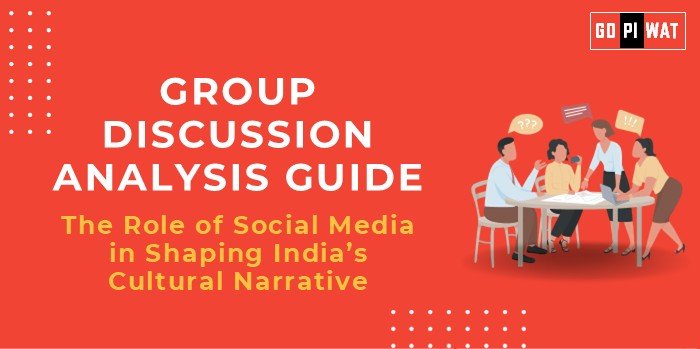📋 Group Discussion (GD) Analysis Guide
🌐 The Role of Social Media in Shaping India’s Cultural Narrative
🌟 Introduction to the Topic
Social media has revolutionized how cultural identities are expressed and shared in India, offering a global platform for local narratives. While platforms like Instagram and YouTube empower creators to showcase traditions, concerns about cultural homogenization and misinformation persist.
📊 Quick Facts and Key Statistics
- Social Media Users: Over 600 million in India (2024).
- Time Spent Online: Average of 2.5 hours daily.
- Regional Content: 80% of consumed content is in regional languages.
- Digital Campaigns: Initiatives like #VocalForLocal promote indigenous traditions.
🤝 Stakeholders and Their Roles
- Government: Promotes campaigns like Digital India and regulates content.
- Social Media Companies: Enable content sharing but face scrutiny for biases.
- Cultural Organizations: Use platforms to preserve and promote traditions.
- Citizens: Act as creators and consumers, shaping cultural discussions.
✅ Achievements and Challenges
Achievements:
- Promotion of local cultures through campaigns like #HandloomDay.
- Highlighting underrepresented practices, such as regional cuisines.
- Global reach through creators like Prajakta Koli.
Challenges:
- Cultural homogenization diluting regional uniqueness.
- Misinformation harming cultural narratives.
- Cyberbullying impacting creators and discussions.
🌍 Global Comparisons and Case Studies
Global Comparisons:
- South Korea: TikTok and YouTube amplify K-pop globally.
- United States: Social platforms drive diverse but polarized discussions.
Case Studies:
- #SaveTheGanga Campaign: Combines cultural and environmental advocacy.
- Viral Rajasthani folk dance videos showcasing traditional art forms.
📌 Structured Arguments for Discussion
- Supporting Stance: “Social media platforms empower regional creators, ensuring cultural narratives reach global audiences.”
- Opposing Stance: “Algorithm-driven content amplifies certain narratives while marginalizing others.”
- Balanced Perspective: “While social media democratizes content, a critical approach is necessary to mitigate cultural distortion.”
💡 Effective Discussion Approaches
Opening Approaches:
- Start with statistics: “600 million Indians use social media daily to connect with their roots.”
- Highlight success stories: “The #HandloomDay campaign boosted global awareness of Indian textiles.”
Counter-Argument Handling:
- Acknowledge concerns about misinformation and propose fact-checking solutions.
- Emphasize the role of public-private collaborations in promoting authentic content.
📈 Strategic Analysis of Strengths and Weaknesses
- Strengths: Amplifies regional voices, fosters creativity.
- Weaknesses: Misinformation prevalence, limited rural digital literacy.
- Opportunities: Cross-cultural collaborations, regional content monetization.
- Threats: Data privacy concerns, loss of authenticity.
📚 Connecting with B-School Applications
- Real-World Applications: Analyzing cultural implications in digital marketing strategies.
- Sample Questions:
- “How can social media campaigns balance global reach with cultural authenticity?”
- “Evaluate the impact of regional language content on India’s digital economy.”
- Insights: Explore data-driven trends for cultural promotion and recognize the interplay between culture and marketing.


